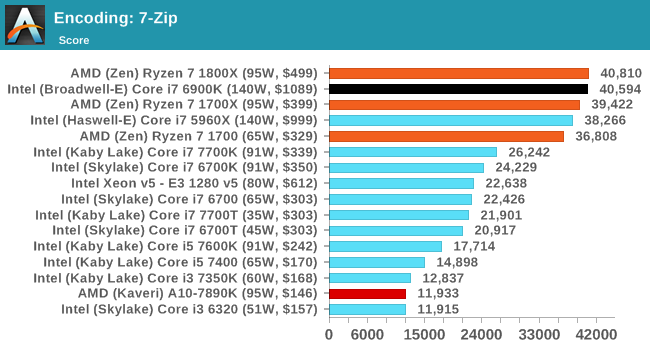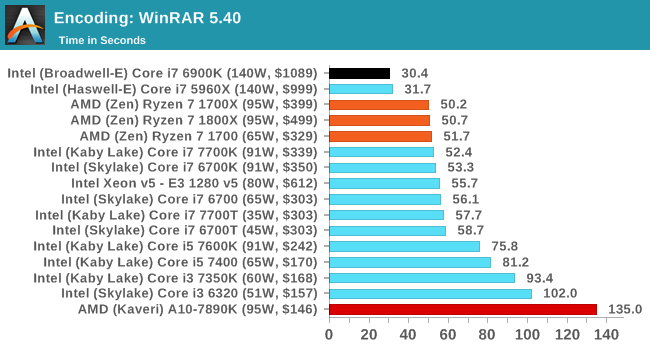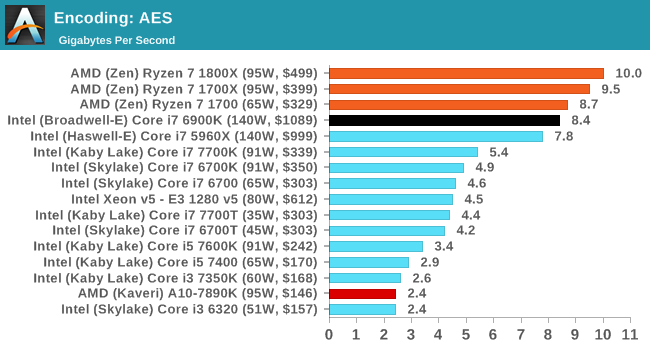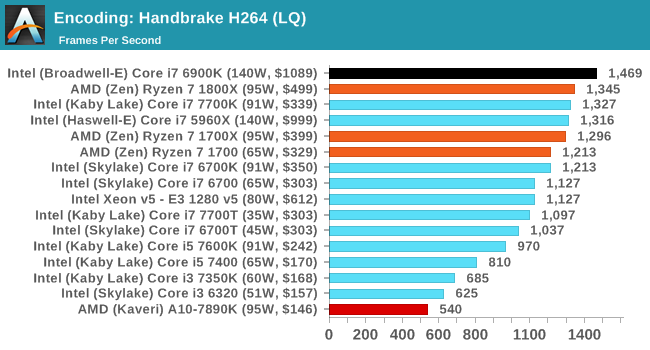The AMD Zen and Ryzen 7 Review: A Deep Dive on 1800X, 1700X and 1700
by Ian Cutress on March 2, 2017 9:00 AM ESTBenchmarking Performance: CPU Encoding Tests
One of the interesting elements on modern processors is encoding performance. This includes encryption/decryption, as well as video transcoding from one video format to another. In the encrypt/decrypt scenario, this remains pertinent to on-the-fly encryption of sensitive data - a process by which more modern devices are leaning to for software security. Video transcoding as a tool to adjust the quality, file size and resolution of a video file has boomed in recent years, such as providing the optimum video for devices before consumption, or for game streamers who are wanting to upload the output from their video camera in real-time. As we move into live 3D video, this task will only get more strenuous, and it turns out that the performance of certain algorithms is a function of the input/output of the content.
7-Zip
One of the freeware compression tools that offers good scaling performance between processors is 7-Zip. It runs under an open-source licence, is fast, and easy to use tool for power users. We run the benchmark mode via the command line for four loops and take the output score.

WinRAR 5.40
For the 2017 test suite, we move to the latest version of WinRAR in our compression test. WinRAR in some quarters is more user friendly that 7-Zip, hence its inclusion. Rather than use a benchmark mode as we did with 7-Zip, here we take a set of files representative of a generic stack (33 video files in 1.37 GB, 2834 smaller website files in 370 folders in 150 MB) of compressible and incompressible formats. The results shown are the time taken to encode the file. Due to DRAM caching, we run the test 10 times and take the average of the last five runs when the benchmark is in a steady state.

AES Encoding
Algorithms using AES coding have spread far and wide as a ubiquitous tool for encryption. Again, this is another CPU limited test, and modern CPUs have special AES pathways to accelerate their performance. We often see scaling in both frequency and cores with this benchmark. We use the latest version of TrueCrypt and run its benchmark mode over 1GB of in-DRAM data. Results shown are the GB/s average of encryption and decryption.

HandBrake H264 and HEVC
As mentioned above, video transcoding (both encode and decode) is a hot topic in performance metrics as more and more content is being created. First consideration is the standard in which the video is encoded, which can be lossless or lossy, trade performance for file-size, trade quality for file-size, or all of the above can increase encoding rates to help accelerate decoding rates. Alongside Google's favorite codec, VP9, there are two others that are taking hold: H264, the older codec, is practically everywhere and is designed to be optimized for 1080p video, and HEVC (or H265) that is aimed to provide the same quality as H264 but at a lower file-size (or better quality for the same size). HEVC is important as 4K is streamed over the air, meaning less bits need to be transferred for the same quality content.
Handbrake is a favored tool for transcoding, and so our test regime takes care of three areas.
Low Quality/Resolution H264: He we transcode a 640x266 H264 rip of a 2 hour film, and change the encoding from Main profile to High profile, using the very-fast preset.

High Quality/Resolution H264: A similar test, but this time we take a ten-minute double 4K (3840x4320) file running at 60 Hz and transcode from Main to High, using the very-fast preset.

HEVC Test: Using the same video in HQ, we change the resolution and codec of the original video from 4K60 in H264 into 1080p30 HEVC. This causes a dramatic reduction in filesize.











574 Comments
View All Comments
Cooe - Sunday, February 28, 2021 - link
Find me these so-called people buying Intel HEDT CPU's (aka OG Ryzen 7's direct competition) for gaming & never for HPC uses.... Oh wait. They don't exist.Haawser - Thursday, March 2, 2017 - link
Yeah, but if you're a gamer who streams, Ryzen is waaaay better than anything Inter offer for $499. Especially if you're gaming at 4K, or going to be. Different people have different needs, even gamers.Jimster480 - Thursday, March 2, 2017 - link
Yes but no,Because Broadwell-E and Haswell-E HEDT platforms are in the same boat as Ryzen.
But this is what this Ryzen 7 release is meant to do.
Compete with the HEDT platforms, not against the "APU" chips.
Those chips will come later, albeit with much higher clockspeeds to compete with intel.
For now you have Intel with 10-20% clockspeed advantages in clockspeed dependent applications.
Meteor2 - Saturday, March 4, 2017 - link
I hope you're right but there's no indication they will be clocked higher. AMD has access to processes which are generation behind Intel's, at least for a couple of years. We can't expect miracles.nos024 - Thursday, March 2, 2017 - link
Lol, butt hurt? Why even bother running gaming benchmarks? You even said it yourself that ryzen wont make it to your so called grown-up workstation because if low pcie count.So tell me who is this $500 Ryzen chip designed for? Not grown ups running workstation, or pathetic kiddies gamers...so theyre for Wannabes?
Tunnah - Thursday, March 2, 2017 - link
He literally said it is ideal to replace his aging 3770k, he gave an example of how it will be used. Try more reading and less being a turdddriver - Thursday, March 2, 2017 - link
Ryzen is that much more affordable that with the price difference I could have built another whole system, dedicated to running the 2 HBA adapters, thus saving on the need of 16 lanes. 40 - 16 is exactly 24, which is what ryzen has. If it was available a year ago I would have simply built two systems, offering a good 50-60% more CPU performance, double the GPU performance, with enough need to accommodate my IO needs, even if between two systems, that wouldn't have been much of an issue.The pci lane count is lower than intel E series chips, however it is still 50% higher than what you can get from intel outside the E series. It will actually suffice in most workstation scenarios, even if you end up running graphics at x8, which is not really a big deal.
ddriver - Thursday, March 2, 2017 - link
"you even said it yourself that ryzen wont make it to your so called grown-up workstation because if low pcie count"I did not say that. Not all workstations require 40 pcie lanes. Most could do with 24. I was talking about my workstation in particular, which has plenty of pcie hardware. For the vast majority of HPC scenarios that would not be necessary, furthermore as already mentioned, with the saved money you can build additional systems dedicated to specific tasks, offloading both the need of more pcie lanes and the cpu time the attached hardware consumes.
It remains to be seen how much IO will the server zen parts have. Ryzen is not particularly a workstation grade chip, it just happens to be GOOD ENOUGH to do the job. AMD give you 50% more performance and 50% more IO at the same or better price point, and I think they will do the same for the chips they actually design for workstation.
It looks like the 16 core workstation chip will have 64 pcie lanes, and the 32 core - a whooping 128 lanes. So intel E series looks like a sad little orphan with its modest 40 lanes... And no, xeons aren't much better, they are in fact worse, the 24 core E7-8894 v4 only has a modest 32 lanes.
So no, while I will not be replacing my main 10 core workstation with a ryzen, because that would win me nothing, I am definitely looking forward to replacing it next year with a Naples system, and I definitely wished ryzen was available last year as I could have spent my money much better than buying intel.
Intel999 - Thursday, March 2, 2017 - link
"So tell me who is this $500 Ryzen chip designed for?"Logic would imply it is aimed at anyone that works in an environment where they need superior multithreading performance. For instance, anyone that has bought a 6900k or 6950k, but more importantly it is for those individuals that "wanted" to buy either of Intel's multi core champs but couldn't due to ridiculous prices.
I'd dare to make a bet there are more people that wanted to buy a 6900k than there are people that actually did. Now they can buy one and still put food on the table this month.
FriendlyUser - Thursday, March 2, 2017 - link
Exactly right. I was always tempted by the 6850K, but the price of the CPU+platform was simply ridiculous. For much less I got a faster CPU and a high-end MB. I won't miss the 40PCIe lanes.